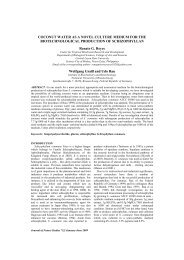Downstream processing of mannosylerythritol lipids produced by ...
Downstream processing of mannosylerythritol lipids produced by ...
Downstream processing of mannosylerythritol lipids produced by ...
You also want an ePaper? Increase the reach of your titles
YUMPU automatically turns print PDFs into web optimized ePapers that Google loves.
Eur. J. Lipid Sci. Technol. 107 (2005) 373–380 <strong>Downstream</strong> MEL 377<br />
facilitate the downstream process. As a result, all polymers<br />
were able to accumulate MEL in different amounts<br />
that could be eluted <strong>by</strong> MTBE or methanol. However, fatty<br />
acids and soybean oil were also adsorbed. A specific<br />
adsorption was not possible <strong>by</strong> the use <strong>of</strong> these resins.<br />
Only a trend to higher adsorption capacity <strong>of</strong> MEL with<br />
simultaneous decreasing accumulation <strong>of</strong> fatty acids and<br />
soybean oil was observed in the order: XAD-16 . XAD-7<br />
. XAD-4.<br />
When the MEL-containing culture suspension was transferred<br />
into a glass bottle, the separation <strong>of</strong> aggregated<br />
MEL beads could be observed at the bottom as highly<br />
viscous fluid (Fig. 4, left picture). This viscous MEL phase<br />
and the MTBE extract <strong>of</strong> the whole culture suspension<br />
(Fig. 3) possessed a similar composition (Fig. 4). After<br />
sterilisation <strong>of</strong> the MEL-containing culture suspension at<br />
121 7C for 20 min, two MEL-containing phases, a solid<br />
sticky and an aqueous one, were formed, both fatty acid<br />
enriched as well as soybean oil depleted (Fig. 4, right<br />
picture). A small volume <strong>of</strong> a primary soybean oil-containing<br />
top phase was also observed. Related to the total<br />
mass <strong>of</strong> MEL (90 g L 21 ) yielded <strong>by</strong> MTBE extraction <strong>of</strong> the<br />
culture suspension before heating, the MEL were distributed<br />
after heating into the solid and aqueous phases <strong>by</strong><br />
89% and 11% (wt/vol), respectively. This solid phase was<br />
easy to separate <strong>by</strong> pouring <strong>of</strong>f the cell debris-containing<br />
supernatant. If necessary, dependent on the intended<br />
application <strong>of</strong> the MEL, the cell debris could be separated<br />
<strong>by</strong> solving the solid phase in ethanol and subsequent filtration<br />
using a pore width <strong>of</strong> 0.2 mm. About 11% (vol/vol)<br />
<strong>of</strong> MEL remained suspended in the aqueous cell debris<br />
phase and could additionally be recovered <strong>by</strong> extraction<br />
with ethanol, centrifugation, rotary evaporation <strong>of</strong> the<br />
solvent and vacuum drying.<br />
Variations <strong>of</strong> time (1, 5, 15, 20 min) and temperature (100,<br />
110, 115, 121 7C) <strong>of</strong> the culture suspension treatment<br />
resulted in a nonessential difference <strong>of</strong> MEL content between<br />
86.2–88.3% (wt-%) in the solid phase. Short incubation<br />
times <strong>of</strong> 5 min led to the formation <strong>of</strong> a turbid<br />
solid phase. The longer the time <strong>of</strong> treatment at each<br />
temperature, the higher was the fatty acid and the lower<br />
the soybean oil content, with a minimum <strong>of</strong> 0.3% (wt-%)<br />
soybean oil and a maximum <strong>of</strong> 13.7% (wt-%) fatty acids<br />
at 121 7C for 20 min (Fig. 4, grouped bars <strong>of</strong> solid phase).<br />
Corresponding to Fig. 4, Fig. 5 shows HPLC and TLC<br />
analyses <strong>of</strong> the MEL-containing phases before and after<br />
heat treatment, as well as the distribution <strong>of</strong> the different<br />
MEL. The maximum <strong>of</strong> 93% (wt-%) MEL transfer into the<br />
solid phase with an appropriate reduction to 7% (wt-%)<br />
MEL in the resulting aqueous phase was achieved at<br />
110 7C for 10 min and was considered as the most effective<br />
treatment for downstreaming the MEL. This solid<br />
phase contained 88.3% (wt-%) MEL, 6.6% (wt-%) fatty<br />
acids as well as 5.1% (wt-%) soybean oil and reduced the<br />
surface tension <strong>of</strong> water/air to 31 mN m 21 (critical micelle<br />
concentration 15 mg L 21 ).<br />
Fig. 4. Composition <strong>of</strong> different MEL phases from a<br />
culture suspension before (left) and after (right)<br />
treatment at 121 7C for 20 min. The analyses were<br />
carried out <strong>by</strong> HPLC.<br />
© 2005 WILEY-VCH Verlag GmbH & Co. KGaA, Weinheim www.ejlst.de



